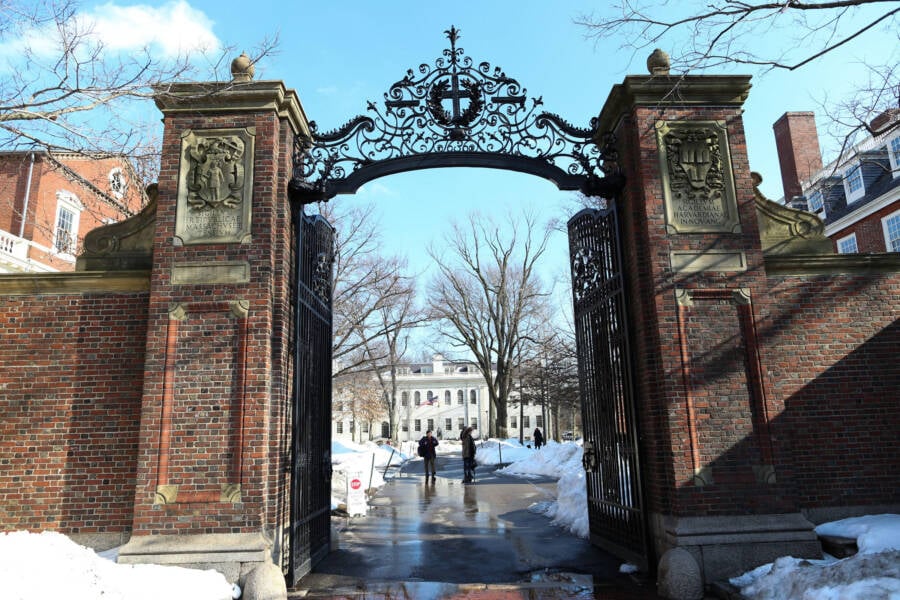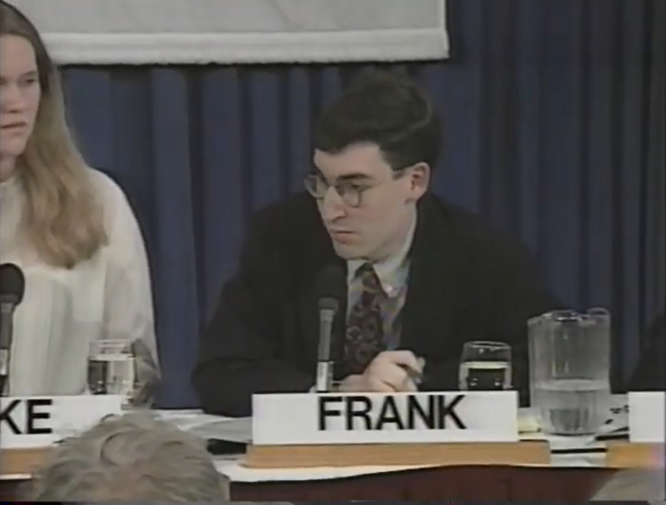On September 13, 1990, 14-year-old Gina Grant bludgeoned her abusive mother to death with a crystal candlestick holder. Five years later, Harvard revoked Grant's admission after an anonymous source notified the school of her criminal history.

Lexington County SheriffGina Grant killed her mother in 1990 after enduring years of abuse.
Gina Grant seemed to be the perfect candidate for admission to Harvard University. Throughout her life, Grant’s friends, mentors, and teachers lauded the honor student for her impressive academic performance, her commitment to her extracurriculars, and her kind disposition.
In 1995, Grant’s hard work apparently paid off when Harvard granted her early admission. But soon after, school officials received anonymously mailed news clippings that revealed a chilling secret about Gina Grant: Five years prior, she had brutally killed her own abusive mother.
Harvard rescinded Grant’s offer of admission, claiming she had misrepresented herself in her application. However, their decision proved controversial, sparking a national debate about admissions discrimination and the bounds of redemption and retribution for crimes committed as a juvenile.
The Early Life Of Gina Grant
Gina Grant was born in 1976 in Lexington, South Carolina. Her family included her father, Charles; her mother, Dorothy Mayfield; and her older sister, Dana.
As a child, Gina was closer to her father than her mother. When he died of lung cancer when she was just 11 years old, Gina was distraught.
Her mother handled the tragedy in her own way. She reportedly blamed Gina for Charles’ death, constantly belittling the young girl and refusing to allow her to display photos of Charles in their home.
Meanwhile, Mayfield was struggling with alcoholism. She allegedly drank herself into a stupor daily, and often left her daughters alone for days on end while she entertained various male companions. On one occasion, Gina woke up to find one of her mother’s male friends dead in their home.
“She saw things that no child should see,” Eddie Walker, a former assistant principal of the Lexington Middle School where Gina was a student, told The New Yorker in 1995.
Over the years, Mayfield’s drinking only got worse — and with it, so did her treatment of Gina. Mayfield reportedly regularly launched into viciously abusive tirades before ultimately passing out drunk. Friends later reported that they often saw Gina with unexplained bruises and injuries, and at one point, Gina ended up on crutches after one alleged beating sent her to the hospital.
The young girl attempted to run away twice. Both times, she was caught and sent back home.

Mary Ellen MarkThe Grant home, where the killing took place.
“It was the worst case of psychological abuse I have ever seen — and I’ve seen other kids who have killed their parents,” Dr. Harold Morgan, a forensic psychiatrist who worked as an expert witness on Gina Grant’s defense team, told The New Yorker.
Despite her tumultuous home life, Gina continued to thrive in school. A gifted student who was beloved by her peers, she served as her school’s first female student body president in the eighth grade and dreamed of becoming a Supreme Court justice or a doctor one day.
But eventually, Gina Grant finally snapped.
The Death Of Dorothy Mayfield
On Sept. 13, 1990, Dorothy Mayfield and Gina Grant got into an explosive fight over Gina’s boyfriend, 16-year-old Jack Hook, whom Mayfield had forbidden Gina to see.
Unable to take it any longer, Gina grabbed a crystal candlestick holder — and bludgeoned her mother 13 times in the head.
Afterward, the 14-year-old mopped up the blood and hid the evidence in a trash bag in her bedroom closet. She then allegedly attempted to make the scene look like a suicide by placing a knife into her mother’s hand and stabbing it into her neck.
Soon after, Gina’s older sister Dana arrived at the house and found it suspiciously locked. She called the police, who soon arrived to a disturbing scene.
And it didn’t take long for them to zero in on Gina Grant as a suspect.
In her police interviews, Gina changed her story several times. Initially, she claimed that her mother had attacked her in a drunken rage, fell down the stairs, and then stabbed herself in the throat, exclaiming, “One of us has got to go.”
Later, Gina claimed that her boyfriend, Jack Hook, had killed Mayfield. Hook denied any involvement, and later said he knew nothing about Mayfield’s alleged abuse.
However, when police discovered the bloody candlestick holder in Gina’s closet and determined it to be the object used to bludgeon Mayfield’s skull, Gina finally confessed that she had hit her mother with the candlestick in self-defense.
Gina Grant Is Tried For Murder

ZUMA Press, Inc./Alamy Stock PhotoThe gates to Harvard University, which famously rescinded Gina Grant’s offer of admission.
At the trial for the killing of Dorothy Mayfield, the prosecution alleged that it had been a calculated murder. The defense, meanwhile, relied heavily on the abuse allegations against Gina Grant’s mother.
One of the most pressing issues for the defense was Grant’s previous assertion that Hook had committed the murder. The prosecution presented as evidence a series of recorded calls Grant had made to Hook’s mother, in which Grant admitted multiple times that Hook was innocent and hadn’t been present during Mayfield’s death at all.
“Perhaps you can understand Gina killing her mother because it was an alcoholic, abusive relationship,” said Hook’s lawyer Stephen McCormack, according to The New York Times. “But can you then justify that, after the fact, she tries to cover it up to the point where she callously implicates someone else and acknowledges to his own mother that she was lying?”
In January 1991, Gina Grant pleaded no contest to voluntary manslaughter and received a sentence of about a year in juvenile detention.
Hook pleaded no contest to being an accessory to voluntary manslaughter after his fingerprints were found on the knife that had been stabbed into Mayfield’s throat. Police suspect he may have helped Grant stage and clean the crime scene after the attack.
Harvard Accepts — And Then Rejects — Gina Grant
After serving about eight months in juvenile detention, Gina Grant moved to Cambridge, Massachusetts to live with her aunt and uncle.
There, she had a chance to start anew in a place where no one knew about her criminal past. She attended Rindge and Latin High School and, to no one’s surprise, excelled academically. She was an honor student with an IQ of 150, a co-captain of the tennis team, a member of the academic decathlon, and a volunteer tutor for underprivileged children.
In 1994, Grant applied to Harvard University for her undergraduate degree. In her application, Grant painted herself as a troubled orphan who had endured impossible hardship and come out on top, excelling in academics and in her personal life. During an interview with the university, she mentioned that her mother had tragically died in “an accident” in 1990 — but neglected to mention that she had been the one to kill her.
Harvard accepted her application, granting her early admission. However, the teen’s joy was short-lived. In the spring of 1995, school officials received several anonymously mailed news clippings detailing Grant’s 1990 criminal trial.

Institute of Politics, Harvard Kennedy SchoolStudents holding a public debate regarding whether Gina Grant should be admitted to Harvard.
On April 3, Harvard officials voted to rescind Gina Grant’s admission offer on the grounds that she had “made material misrepresentations” of herself.
The Aftermath Of The Admissions Controversy
When news broke of Gina Grant’s rescinded offer of admission, it caused a substantial public outcry among Harvard students, and then among the larger public, who felt that Grant was being discriminated against.
After all, juvenile criminal records are typically sealed to protect young offenders from discrimination and to allow them a second chance to succeed. In fact, Massachusetts schools are prohibited from asking applicants about criminal matters that did not result in a conviction.
However, as Boston attorney Alan Rose told The New Yorker, Harvard was a private institution capable of rejecting applicants with violent pasts.
“Harvard is entitled to establish rules about who should go to school there,” he stated. “And on the top of the list of applicants you’d screen out are any who have directed bodily harm at anyone else.”
While top media outlets ran editorials about her case and Harvard students staged protests in her name, Gina Grant herself did not appear to make a big issue of her case. She even reportedly turned down book offers, movie contracts, and TV interviews, opting instead to issue a simple statement.
“I deal with this tragedy every day on a personal level,” she said, according to the Sunday Times Magazine. “It serves no good purpose for anyone else to dredge up the pain of my childhood. In addition, I have no wish to defame my mother’s memory by detailing any abuse.”
In the end, Gina Grant quietly accepted an offer to enroll at Tufts University. As of today, her whereabouts are unknown.
After reading about Gina Grant, dive into the story of Gypsy Rose Blanchard, the abused daughter who organized the murder of her mother. Then, read about the tragic story of Cinnamon Brown, the teen who killed her stepmother on her own father’s orders.





